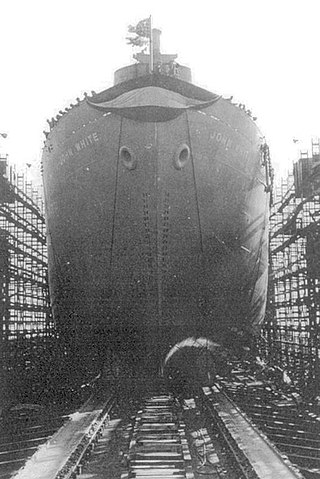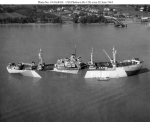
USS Arided (AK-73), a Crater-class cargo ship, is the only ship of the US Navy to have this name. She was named after Arided, the other name of Deneb, the alpha star of constellation Cygnus.

USS Fuller (AP-14/APA-7) was a Heywood-class attack transport in service with the United States Navy from 1941 to 1946. She was scrapped in 1957.
USS Prince Georges (AP-165/AK-224) was a Crater-class cargo ship in the service of the US Navy in World War II. Named after the Prince George's County, Maryland, it was the only ship of the Navy to bear this name.

USS Celeno (AK-76) was a Crater-class cargo ship in the service of the US Navy in World War II. Named with a variant spelling of the star Celaeno in the constellation Pleiades, it was the only ship of the Navy to bear this name.

The USS Alnitah (AK-127) was a Crater-class cargo ship in the service of the US Navy in World War II. Named a spelling variation of the star Alnitak in the constellation Orion, it was the only ship of the Navy to bear this name.

USS Kenmore (AP-162/AK-221) was a Crater-class cargo ship built during World War II for the US Navy. Kenmore was named after George Washington's sister Betty's house Kenmore. Kenmore was responsible for delivering troops, goods and equipment to locations in the Asiatic-Pacific Theater.

USS Mintaka (AK-94) was a Crater-class cargo ship commissioned by the US Navy for service in World War II. She was named after Mintaka, a star in the Orion constellation. Mintaka was crewed by United States Coast Guard personnel and was responsible for delivering troops, goods and equipment to locations in the Asiatic-Pacific Theater.

USS Sterope (AK-96) was a Crater-class cargo ship commissioned by the U.S. Navy for service in World War II. She was responsible for delivering troops, goods and equipment to locations in the war zone.

USS Caelum (AK-106) was a Crater-class cargo ship commissioned by the US Navy for service in World War II. Caelum was named after the constellation Caelum. She was responsible for delivering troops, goods and equipment to locations in the Asiatic-Pacific Theater.

USS Rotanin (AK-108) was a Crater-class cargo ship commissioned by the United States Navy for service in World War II. Rotanin, which is a misspelling of the name "Rotanen", was named after the star Beta Delphini, a star located in the constellation Delphinus. She was responsible for delivering troops, goods and equipment to locations in the Asiatic-Pacific Theater.
USS Alkaid (AK-114) was a Crater-class cargo ship, converted from a Liberty Ship, commissioned by the US Navy for service in World War II. She was first named after William G. Sumner, a classical liberal American social scientist. She was renamed and commissioned after Alkaid, a star in the Big Dipper asterism or constellation Ursa Major. She was responsible for delivering troops, goods and equipment to locations in the war zone.
USS Zaurak (AK-117) was a Crater-class cargo ship commissioned by the U.S. Navy for service in World War II. She was responsible for delivering troops, goods and equipment to locations in the war zone.

USS Matar (AK-119) was a Crater-class cargo ship, converted from a Liberty Ship, commissioned by the US Navy for service in World War II. She was first named after Napoleon B. Broward, an American river pilot, captain, and politician; he was elected as the 19th Governor of the US state of Florida. She was renamed and commissioned after Matar, a binary star in the constellation of Pegasus. She was responsible for delivering troops, goods and equipment to locations in the war zone.

USS Menkar (AK-123) was a Crater-class cargo ship, converted from a Liberty Ship, commissioned by the U.S. Navy for service in World War II. She was first named after John White, a settler among those who sailed with Richard Grenville, to present-day North Carolina, in 1585, to found the Roanoke Colony. White acted as artist and mapmaker to the expedition. He became the governor, in 1587, of the colony, and his granddaughter, Virginia Dare, was the first English child born in the Americas. She was renamed and commissioned after Menkar, the second-brightest star in the constellation of Cetus. She was responsible for delivering troops, goods and equipment to locations in the war zone.

USS Lesuth (AK-125) was a Crater-class cargo ship commissioned by the US Navy for service in World War II. Lesuth was named after the star Lesuth in the constellation Scorpius. She was responsible for delivering troops, goods and equipment to locations in the Asiatic-Pacific Theater.

USS Megrez (AK-126) was a Crater-class cargo ship commissioned by the US Navy for service in World War II. Megrez was named after Megrez, a star in the constellation Ursa Major. She was responsible for delivering troops, goods and equipment to locations in the Asiatic-Pacific Theater.

USS Phobos (AK-129) was a Crater-class cargo ship commissioned by the U.S. Navy for service in World War II. She was responsible for delivering troops, goods and equipment to locations in the war zone.

USS Ascella (AK-137) was a Crater-class cargo ship commissioned by the US Navy for service in World War II. Ascella was named after Ascella, a star in the constellation Sagittarius. She was responsible for delivering troops, goods and equipment to locations in the Asiatic-Pacific Theater.

USS Mendocino (APA-100) was a Bayfield-class attack transport that served in the United States Navy from 1944 to 1946. In 1947, she was sold into commercial service and was scrapped in 1973.

USS Harris (APA-2) was an Emergency Fleet Corporation Design 1029 ship launched for the United States Shipping Board (USSB) on 19 March 1921 by Bethlehem Shipbuilding Corporation, at Sparrows Point, Maryland as Pine Tree State. After operation by commercial lines for the USSB, during which the ship was renamed President Grant and operated commercially until laid up in the late 1930s.

















